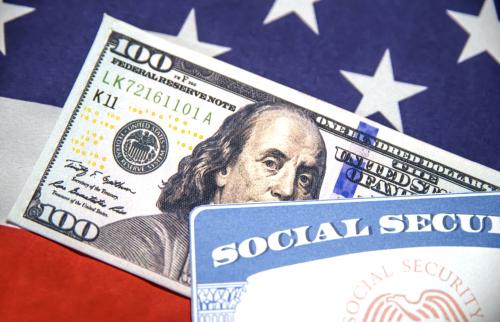Most of the people who say the stock market is going ever higher have a stock they want to sell you, but that doesn’t mean they’re wrong. The average stock listed on the New York Stock Exchange may be up 60% from two years ago and may be selling for more than 20 times last year’s earnings, but this is a new year and earnings have been jumping at most of the big corporations. Economists from a wide spectrum of political belief think the country is doing just fine. A higher fraction of working-age Americans are actually at work than ever before in our history, and they’re spending what they earn.
From the early 1970s to the early 1990s, the share of gross domestic product taken by profits was a declining line of the graph. In this decade, it’s been rising. Labor and agricultural produce and raw materials we have in abundance these days, particularly with the “less developed countries” coming on line as producers for the global market. It’s capital that’s scarce, investment funds to build the factories and computerize the world, and the big rewards go to the proprietors of the factor of production that’s scarce. The rest of the world is investing heavily in America, and as the dollar gets steadily stronger—it’s up nearly 50% against the Japanese yen over the past 20 months—they make more money in terms of their own currencies and get steadily more involved. Meanwhile, the strong dollar guarantees against inflation here, because it means that manufacturers who might wish to raise prices have to worry about cheap imports. Even the government looks good. No other major country has a budget deficit nearly as small as ours by comparison with its gross domestic product.
Internally, moreover, today’s stock market is not behaving like a casino, as it did a few years ago. Then the dominant factors were the professional managers of the big pension funds and insurance companies and bank trust departments who were prisoners of mathematical theories that looked at the whole market as one commodity, with prices of all stocks more or less controlled by price movements in the artificial market for stock index futures. Being very sophisticated themselves and reporting to very sophisticated clients, everyone having been taught that nobody “beats the market,” these managers bought and sold according to formulas that supposedly guaranteed they would do at least as well as the index. The prices of individual stocks—the value of real companies—moved around with no reference to how well those companies were doing.
Today’s market, however, is dominated by the mutual fund customer who is investing his own individual 401(k) pension plan and will buy the fund he thinks can beat the market. Human judgment, good or bad, has returned to the market. Whole sections of the market—the telephone and power-and-light companies, for example—did not rise in 1996 even though they are part of the indices, for the very good reason that their industries have looked less profitable. Through much of the 1995-96 bull market, high-technology companies have been on a yo-yo as opinion shifts back and forth about the likely profitability of chip-makers and computer-makers and Internet service providers and guys who promise to fix your computer so the arrival of the year 2000 won’t throw its clock out of kilter. This is the way a market should behave, responding to evidence from the real economy, not computer programs.
And the best thing about the retirement money is that it comes out in a constant stream, maybe $ 200 billion a year. Bull markets collapse when the last buyer who can be sold stocks has made his purchase. Then the next seller—who may need cash to send kids to college or buy a house or distribute an estate or keep himself going after a layoff—finds that he has to cut his price to make his sale. Because everybody has already bought, everybody is upbeat and euphoric and sure the market will rise forever; and now, the last customer satisfied, the next seller affrighted, the market shivers its timbers and begins to hit icebergs. But until they can think of some other place to put the money, which at worst will take a while, 401(k) beneficiaries provide a never-ending supply of buyers.
Somewhere there will be a price level that is so far out of whack with the potential earnings on the investments that the air will roar out of the balloon. In 1968, when I wrote a book on “The New Breed on Wall Street,” market sophisticates cheerfully bought “the greater fool theory”—doesn’t matter how much I pay for a stock, there’s a greater fool who will soon pay more to buy it from me. In 1969, the market went splat. In 1997, one doesn’t in fact hear such comments, one doesn’t feel that ominous drop in barometric pressure that presages a storm.
At its current level, this market is still OK.
The Brookings Institution is committed to quality, independence, and impact.
We are supported by a diverse array of funders. In line with our values and policies, each Brookings publication represents the sole views of its author(s).



Commentary
Op-edFed By A Gusher Of Pension And 401(K) Money, The Market Is Behaving Well. Economists Are Optimistic.
January 29, 1997